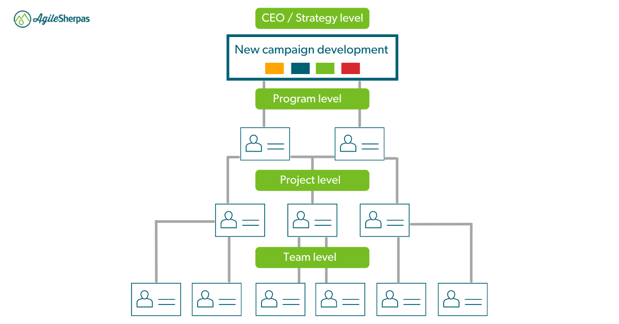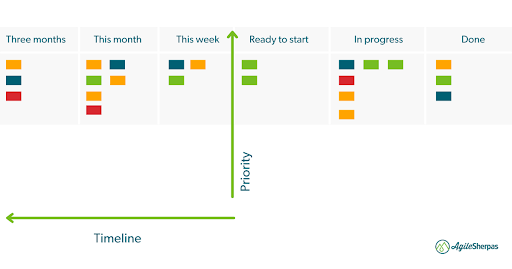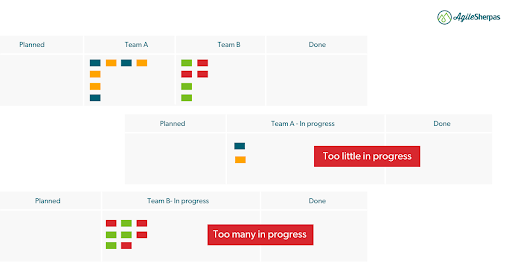When marketing teams get a strong grasp of the Kanban framework, they deliver better and more frequent value to the customer. However, when campaigns move rapidly, critical visibility of the bigger picture can get lost.
Tasks get done efficiently, but the connection between the team and the higher initiative is missing.
In addition, even when you're aiming at business agility, managing multiple Kanban boards within a single organization can be chaotic, painful, and confusing. It’s hard to keep track of what’s going on, and this can sabotage the organization’s chances for improvement.
To keep a clear sight of the landscape, Agile marketing organizations can adopt the concept of Portfolio Kanban as a fresh approach to keeping up with projects.
Portfolio Kanban is a management method that applies Kanban's principles and practices to improve delivery capabilities across multiple teams, or an entire organization.
The main objective of this method is to limit work in progress (WIP) from strategy to execution, continue to deliver higher value to the customer, and manage the flow on an organizational level.
Let’s see what exactly Portfolio Kanban is and how you can use it to connect business objectives and projects to user stories and tasks on the execution level.
What is Portfolio Kanban?
Portfolio Kanban is a holistic method to manage multiple projects, also known as initiatives, via visualization. This is one of the most simple, yet powerful visual portfolio management tools. We’re going to dive into the details of its application and best practices.
Portfolio Kanban helps organizations oversee and manage a hierarchy of Kanban boards that are related and need to be supervised simultaneously. It presents a higher-level view of workflow status, health, and risks across teams.
The method can be scaled across multiple levels within the marketing organization, from the team level to mid-level project management and all the way up to C-level executives.
The sole purpose of Portfolio Kanban is to follow the progress status of initiatives and tasks at any given time and on any level. In addition, it supports organizations to focus on flow, WIP limits, and explicit policies.
Remember, Portfolio Kanban is not the same as Team Kanban.
The big difference between them is that cards on a Portfolio Kanban board are the origin of the cards included on the Team Kanban board.
For example, a new request is added to increase website traffic on the strategic level. This card goes on the Portfolio Kanban board and breaks down into actionable tasks on the team board.
In this case, the cards on the Team Kanban board will include link building, ads, and new pieces of relevant content required to deliver on the higher objective.
Preferably, the status of a card is synchronized on both boards based on its progress in the Team Kanban board. For this, you’ll need a process management tool with "if this, then that" automations.

There are four different ways to use the Portfolio Kanban method to connect teams and manage workflows. Let's check out your options so you can find the best one for your needs.
Team Level (User stories or Tasks)
As mentioned above, it is possible for team visibility to suffer when moving quickly through tasks and campaigns. Teams can lose touch with the essence of the project or initiative.
The approach to recover that visibility is by implementing a Portfolio Kanban workflow in the Team Kanban board. Usually, it’s a simple area placed at the top of the Kanban board where the initiatives are being visualized.
This way, as tasks progress, the initiatives of which they are derivative are evident to each team member.
Project Level (Projects or Features)
Managing and executing projects on a cramped timeline is tough even for the best of us. Using Portfolio Kanban, you can break big projects into MMF (minimal marketable features) and then to user stories, also known as team tasks.
Then, let the team pull each card at their own speed so members are able to maintain a steady pace and ensure the quality execution of each card.
It is strongly recommended to start working on a new MMF only when the previous one is finished. This way nothing is left behind.
This approach is great both for a small marketing team or multiple teams. With the Portfolio Kanban board, teams can work on their dedicated Team Kanban board while you supervise the flow of MMFs on the Portfolio Kanban board.
This outlook is very helpful for teams to stay in sync and work in parallel with each other so more gets done.
Program Level (Epics)
The approach using Portfolio Kanban on a program level is the same as on a project. The small difference is that you add a new board “above” the project one and link all the MMFs to a single card on the program Kanban board.
Program level Kanbans eliminate the need for recurring status meetings and email updates to leadership, so the teams can focus on doing awesome work.
Strategic Level (Objectives and Key Results)
The Kanban approach can even be used at the highest levels of an organization for best results. Annual or quarterly OKRs can be tracked on a visual workflow, consolidating updates from all of the program-level work items flowing towards completion on their respective boards. In this way, strategic initiatives are broken all the way down to tasks on the team Kanban board, so there is always alignment from Strategic objectives to tasks.
Implementing a Portfolio Kanban Roadmap
As anyone who's ever gotten a time estimate on a project knows, people aren't always the best at predicting how long something will take them to complete. Usually, our expectations don’t match with reality. This leads to delays that make the execution process stressful and more difficult for participating teams.
That’s why project roadmaps are crucial for keeping stakeholders in touch with the current status of their requests.
Often, traditional roadmaps are tied to fixed deadlines and scope. Yet, the scope can change, and so does the date of final delivery.
In order to create a Kanban roadmap, you need to have a dynamic Portfolio Kanban board in place. Usually, the board consists of projects or MMFs. As we already know, they are broken down into tasks.
When making a Kanban roadmap, the primary focus should be on the Requested / To-do area. Depending on the project and scope, you can add as many columns as you need to.
We will use the graphic below as an example. As you can see, there are three columns in the timeline - this week, this month, and three months. The cards you put in each column should get done according to the corresponding timeline.
This means that the tasks in the “this week” column should be finished this week. The same goes for this month and three months. The higher the task is in the column the higher should be the prioritization to complete it.

You can adapt this approach to fit your needs best. Make the timeline serve you and support you to get information about the workflow with just a glimpse.
The Benefits of Cascading Epics
Managing complex tasks among different teams can be a challenge, especially if you’re the one expected to report on all of them. However, the process is much smoother when you implement Epics at the program level and cascade them down, dividing the work up among the relevant teams as you go.
Let’s say we have a website redesign that requires collaboration from two groups - marketing and sales. What usually happens is that departments work independently and don’t know what the other one is doing. This results in redundancies, overlap, and misalignment.
As a result, teams and departments can quickly find themselves in trouble when working on the same Epic without syncing.
The right visualization and metrics can help these collaborating teams stay on track.

In Agile marketing, there are some valuable metrics you should use to measure success. The one we care about in this context is flow efficiency. This is “the ratio between value-adding time and the total cycle time”.
Cycle time is the amount of time a team spends actually working on an action item up until its completion. In other words, the time it takes to complete one task. The total cycle time is defined by dependencies such as waiting on another team member or department to complete their part.
Measuring time spent waiting and time spent blocked is complicated given that we have different and constantly shifting circumstances. In addition, that time depends on whether tasks can be done simultaneously or not.
That’s why it’s important for leaders to be able to track the flow efficiency to gain deeper insights, optimize the workflow, and minimize waste.
The visualization of the work as Epics gives other departments and stakeholders a better level of understanding of the work volume that is in progress and must be prioritized.
So, let’s picture a real situation where a marketing department is working on 25 Kanban epics. The epics break down into 100 tasks and are being worked on by 3 teams - design, content, and ads. It’s painful to manage and things take a tremendous amount of time to complete.
This lack of coordination can lead to unpleasant delays and disruptions. Thanks to Epics, organizations have an objective way to discuss planned work prior to committing the necessary people, time, and resources instead of taking an action at the last minute. That’s why managing flow efficiency on a higher level is a must for successful and efficient work processes.
Global WIP Limits
Too much WIP is a common pain all marketers share. There are tasks or projects that look like they will be ongoing forever, so they linger in the In Progress area of our boards for way too long. If you have dependencies across teams, it’s recommended to start looking into a Kanban Portfolio visualization to manage them.
If a team working in a bubble adopts new ways for boosting productivity, such as Kanban, they will be able to contribute more and deliver rapidly within the confines of their own workflow.
Yet, this can become a problem on a wider scale, since the other collaborating teams can’t keep up with that pace. If one team is faster than the other it will look like that:

Implementing Portfolio Kanban and global WIP limits will prevent getting started on new tasks even if one or both teams has the capacity.
Limiting global WIP will boost the flow of delivery and value through the organization. It will make the teams more efficient as a unit, instead of efficient in isolation.
In addition, adding work in progress limits means that there is a constant conversation about what is truly a priority for the group and what is nice to have.
Agile Across All Levels
Portfolio Kanban can give business and marketing organizations visibility of problems they didn’t even realize they have.
Truly Agile organizations don’t apply Kanban only on a team level. They scaled it across all levels within the organization. That’s how they can reap the full benefits of the Kanban tools and practices.
Organizations that include Portfolio Kanban as an element of their upper management can connect the dots from task to project, mitigate bottlenecks, and transform the organization to be globally optimized and competitive. Now, it’s your turn!